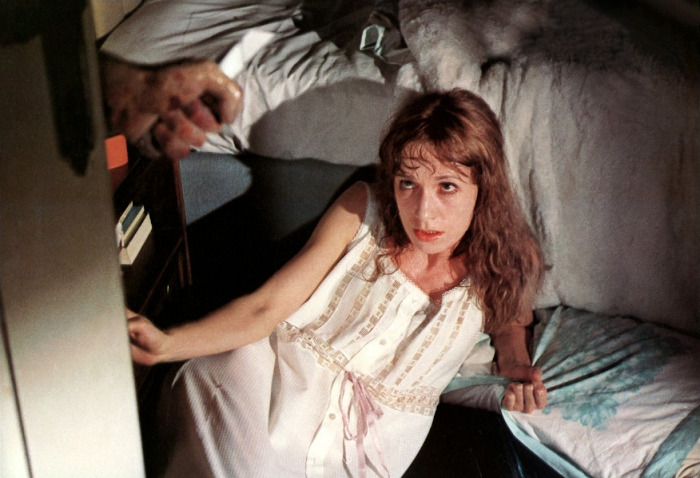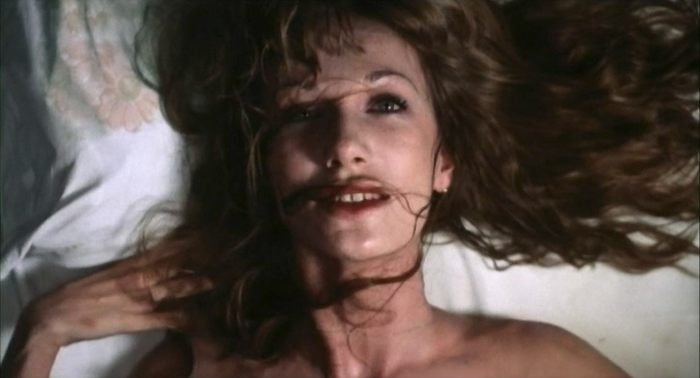Original title: Schock
Mario Bava’s last feature film (he directed the La Venere d’Ille episode of the television mini series I giochi del diavolo (1979) before his death in 1980) has long polarised opinion, some maintaining that it was one last masterpiece, others dismissing it as primarily the work of Bava’s son Lamberto and hardly worthy of inclusion in the grand old master’s formidable filmography. As ever the truth lies somewhere in between. It’s a far cry from the heady glories of La maschera del demonio/The Mask of Satan (1960), 6 donne per l’assassino/Blood and Black Lace (1964), Operazione paura/Kill Baby Kill (1966) et al but it’s a perfectly serviceable occult chiller with a few flashes of Bava’s trademark visual panache.
Dora Baldini, her seven-year-old son Marco and new husband Bruno move back into he home that Dora formerly shared with her abusive first husband Carlo who kept her drugged before apparently committing suicide. Dora was incarcerated following a nervous breakdown and once back at the house, with airline pilot Bruno away from home much of the time, she starts to feel vulnerable and anxious again. Matters aren’t helped by Carlo’s ghostly return to the house, possessing Marco. The truth about Carlo and Dora’s relationship and particularly his death is literally sealed up in the basement and as Dora becomes increasingly unhinged, Marco falls further under the malign influence of his dead father.

Bava is notably hindered throughout by a lack of budget that tends to scupper some of his more ambitious effects (the flying Stanley knife is more silly than terrifying) but for the most part he’s simply too good a director to let such things hold him back. Elsewhere there’s a gloriously weird shot of Dora’s hair moving in a disturbingly unnatural manner during one of her nightly visitations from her dead husband, a simple enough effect (Daria Nicolodi is clearly being turned upside down to achieve the movement) but one that works rather creepily.
Bava is having most fun with the hallucinatory flashback sequences and dreams. He’s often thwarted by sub-standard special effects (including a disembodied crawling hand that even Amicus, owner of cinema’s least persuasive severed appendage, wouldn’t have felt threatened by) but there’s a psychedelic unearthliness about Dora’s flashback to her drug-fuelled past.

If the score often sounds reminiscent of the work of Italian prog-rockers-turned -soundtrack-composers Goblin, this is perhaps unsurprising. The music for Shock was provide by another prog band, Libra who for many years were suspected of being a pseudonym for Goblin. In fact they were very much their own men, recording their first self-titled album in 1975. They didn’t enjoy the success of Goblin (the soundtrack album to Shock was their fourth and final release) though the similarity of sound between the two bands might be down to the fact that they shared some personnel, drummer Walter Martino having been a founder member of Oliver, the band that eventually became Cherry Five and then Goblin and guitarist Carlo Pennisi went on to join Goblin in 1978 in time for their soundtrack to Bruno Corbucci’s Squadra antimafia.
There’s been talk of the film’s supposed ambiguity over its supposed supernatural happenings, that Bava was leaving it up to us to decide if there really was something unnatural going on or if it was all in her mind. Watching the film dispels this oft-repeated canard straight away – clearly supernatural things happen when Dora isn’t there to witness them (the chilly final shot for example) and while some of the things she sees and experiences may be a result of her shattered psyche there’s never any real doubt that the supernatural is at work in some way.

The most disturbing and unsettling aspect of the film comes not with its ghostly manifestations or trippy flashbacks but with Marco’s post-possession behaviour towards his mother. Early on, Dora and Bruno make love of the soft, a large porcelain hand turning to point an accusing finger while in his room, Marco, presumably at the very moment that his father takes control, repeats “pigs!” over and over again. After that, the long deceased Carlo (played in flashbacks by an uncredited Nicola Salerno) is in charge and young Marco start to exhibit increasingly inappropriate behaviour, lusting after his mother while she takes a shower or writhing around while lying on top of her. In the UK the film was initially cut though it seems that this was done primarily to trim the running time rather than the result of censorial interference though the scene of Marco lying on his mother in the garden seems to have been conspicuously trimmed.
The budget probably dictated that the cast remain small. Apart from a couple of removal men (one of who is played by Lamberto), a small role for Ivan Rassimov as a doctor and a gaggle of extras Shock is essentially a three-hander. John Steiner looks strangely like porn legend John Holmes in several shots and of the three principals is given the least to do, just drift in and out of the plot as screenwriters Lamberto Bava, Gianfranco Barberi (credited as Francesco Barbieri), Alessandro Parenzo (credited as Paolo Brigenti) and Dardano Sacchetti find space for him. David Colin Jr had form playing spooky kids, having turned up in Ovidio G. Assonitis and Robert Barrett’s Chi sei? (1974), marketed in the States as Beyond the Door which lead to Bava’s film being released there as the inappropriate and misleading Beyond the Door II. Colin, despite the enormous drag factor of the film’s worst dub, is creepily effective as the possessed boy and his final shot, pouring tea for his invisible friends, is one of the film’s most memorable. Acting honours though go to Daria Nicolodi who excels herself as the increasingly hysterical Dora. Some have suggested that it’s her best performance though with the English dubbing getting in the way that’s hard to verify, but she is very believable as a woman spiralling back into madness.

How much of Shock was actually shot by Mario and how much Lamberto, who took over when his father became ill (some reports suggest that Bava Junior shot up to a quarter of the film). Perhaps it doesn’t matter. It’s a creepily effective curtain call for one of Italian horror’s pioneers. It may not scale the heights of his Gothic masterpieces (few films do) but it shows that even to the (almost) end he was still capable of crafting fine genre films. It arrived at a time that did it few favours – the giallo that Bava had pioneered in the 60s had been reinvented in the early part of the decade by Dario Argento and Lucio Fulci was waiting in the wings to ramp up the gore with the global success of his series of increasingly audacious gore films.
As such, Shock feels a little out of time, too late to capitalise on the occult boom initiated by The Exorcist (1973), too early for the post The Amityville Horror (1979) interest in ghosts and haunted house films and, by the time it belatedly opened in UK cinemas three years later (on a double bill with Vicente Aranda’s La novia ensangrentada/The Blood Spattered Bride (1972), it was looking a little anaemic compared to the visceral onslaught of Fulci’s Zombi 2/Zombie Flesh Eaters (1979) which also graced UK cinemas in 1980.
I kind of like this, even despite the dubbing and slightly shonky feel; they ripped off The Prodigy jump-scares from this one a few years ago.
LikeLiked by 1 person